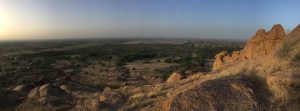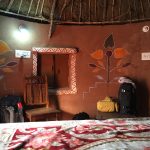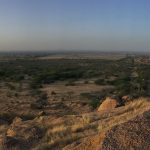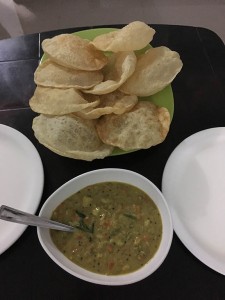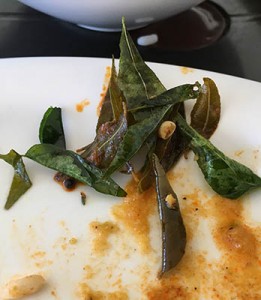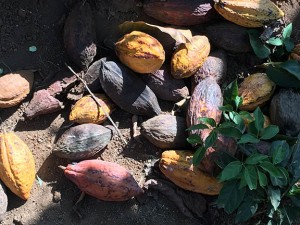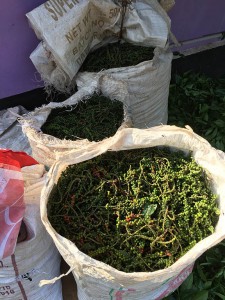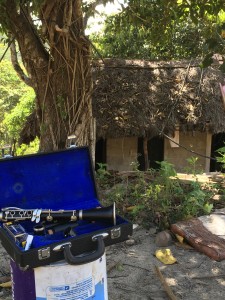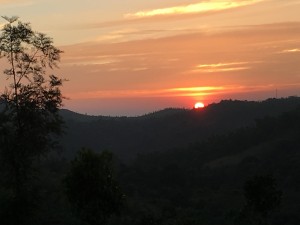Malayalam is a palindrome, as Molly, an educator and the wife of our host at Palette People, Cyril Jacob, pointed out when we met her at her tasteful and impeccably clean home in Cochin. Malayalam is also the main language of the state of Kerala, the first state in the world that voted in a communist government. When we were ready for our trip to India, we looked online for language instruction. We signed up for Hindi101, where a lively Indian woman by the name of Perna teaches you short and useful phrases such as "Namaste, meera nam [Perna] hai" (Hello, my name is [Perna].) "Aap se milker khushi huy" (Nice to meet you). And so forth. Little did we know that in Kerala people don't speak Hindi. I pointed this out to my colleague and guide in all things India, Frank Korom, who explained.
Yes, no red-blooded Dravidian would ever be caught dead speaking Hindi, but some South Indian Muslins speak Urdu or a dialect of it, especially on Hyderabad. Hindi was arbitrarily chosen as the lingua Franca because of the majority of politicians who brought the Nehruvian Dynasty into power at the time of independence, but Tamils, especially, are avid linguistic nationalists. In fact, the first suicide bombing during the freedom movement was a Tamil nationalist who blew himself up at the Madras railway station shouting "Long live Tamil Tay!" (Tay is Tamil for Goddess, so the language became deified). Malayalam spoken in Kerala was thought of historically to be a dialect of Tamil. The Dravidian languages are quite different from the Sanskritic languages of the north, as you'll notice when you proceed in that direction... [spelling not corrected]
The interactions I am describing here (with Molly and with Frank) are typical for how we learn here. With little background and minimal preparation we stumble around, observe things, speculate about what or why they are, and eventually someone who knows will answer our questions. There's a lesson for us educators here. [When you want for information to make sense to your students, make sure they show some signs of curiosity first. (Duly noted for when I return to teaching.)]
Malayalam (the language) has lots of syllables, and often we cannot make out the sounds even when we ask people to repeat certain words for us, terms we've heard repeatedly but cannot quite remember. Miriam writes things down, she asks everyone over and over again. She is determined. She is also a language teacher and we're both struck by how hard it is to even hear what sounds people are making, let alone reproduce them correctly. By now we've lost all shame, though. We repeat what we hear, which sounds funny to the people we bother for linguistic information, and so everyone gets something out of it.
Not by accident perhaps, the first Malayali word that stuck was "ba." Cyril used it when he spoke to a cow in the dell below the residency. People use it for animals and for one another. It means "come." The word is similar to the Hebrew word for "come" ("bo"). Perhaps that's why we caught on quickly and like the word. I can say it like a native and waggle my head for emphasis, much to the delight of the tea ladies for whom we put on a marital gender performance every afternoon. (Miriam is the empowered woman, I am the silly cum jovial man.) What I really like about "ba" is that it reflects the character of the people. We feel entirely welcome here. People don't look at us askance. They are curious. Miriam ropes them into writing the names of things she draws on strips of fabric (really: cut-up bed linen) in Malayalam and Tamil, as well as their own names, and they're completely game. They take charge, they correct one another. They've adopted us. There is mutuality. There is a lot of "ba," an invitation to see, to share, to appreciate the work, the landscape, the orchards and plantations, the fruit of everyone's labor, a cup of tea or coffee, the moment at hand.
We don't take this for granted. I grew up in a village, or rather in a small development located between a village and the nearby town, where even people who lived there, for example ourselves, were not considered quite trustworthy unless they had lived there for generations. People smiled, but we always felt their smiles were insincere. ("Net hinne wie vorne," as we said in the inimitable dialect of our region.)
Today, as we walked back to the residency after a morning of such encounters in Uluppuni, I remembered the similarities between what we experience here and the time I lived in an Arab village on the eastern slope of Mount Olives. The name of the place is El Hardoub. Today it is more crowded and surrounded by bypass roads and barriers, trappings of Israel's bizarre policies of encroachment onto Palestinian territories and the exclusion of Palestinian populations. Back in 1983, things were very different. East Jerusalem was still physically connected to the West Bank. You could drive everywhere. There was no separation wall. The atmosphere was much less poisonous. People were curious. Three of us (Germans, two of us studying Talmud at the Hebrew University, which was in walking distance, the third of us worked in a home for handicapped children in El Azarie, also within walking distance), rented an apartment from a young couple with two small children (Ashraf and Shemiran) in a house they shared with the husband's parents and two unmarried siblings. When we moved in, the grandmother had just returned from the haj and we received small gifts from her in celebration of her return from Mecca. At night we'd sometimes watch television with our hosts who would turn the set to one of the Hebrew channels since we knew Hebrew but not Arabic. Hebrew was our common language. There was no issue, no tension, only good will and mutual curiosity. Exactly as it is for us here around the village of Uluppuni. Back in El Hardoub, people also got used to us going to and fro, appearing on the steep main road and walking at any time, day or night, going about our business without apprehension. Occasionally the winds turned. There could be tension. Street urchins might throw pebbles at us, testing our responses. Even then, there were times when one could not ignore the occupation, though by and large, Israel was more or less invisible and the state was less heavy-handed. West Jerusalem offered opportunity for workers and tradesmen like our landlord, Muhammad, an electrician. But there was a difference. The people of Kerala are the proud inhabitants of their own land. They may support or resent the central government, but they are not under foreign occupation. They can be generous because they are not encroached upon, or excluded. I wish things were still as they were for the good people of East Jerusalem, though even then they were far from ideal. Now they're much worse. But I've already written that book. (Read all about it!)
UPDATE (courtesy of Frank Korom):
Tamil is the oldest attested Dravidian language (earlier than Malayalam), and the earliest epigraphical evidence is from 254 BCE. Malayalam developed out of Late Old Western Tamil dialects spoken on that side of the Western Ghats. Consequently, Malayalam lost subject-verb agreement and also became heavily Sanskritized, much more so than Tamil, even today. Anyway, in the earliest recorded period, Tamil was spoken all over south India.
